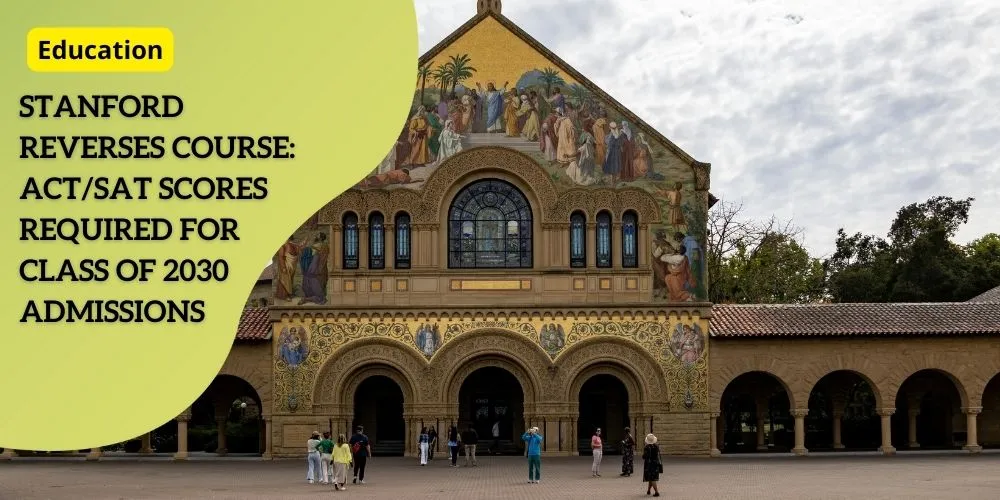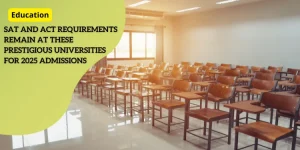Stanford Reverses Course: ACT/SAT Scores Required for Class of 2030 Admissions

Anúncios
Stanford Reverses Course on Test-Optional Policy
Stanford University has decided to reinstate ACT and SAT requirements for admissions starting with the class of 2030, reversing the test-optional policy adopted during the COVID-19 pandemic in 2020. The university believes that requiring these standardized tests will provide them with more comprehensive data on applicants’ academic readiness, helping to make better-informed admissions decisions.
The Catalyst for Change
During the height of the pandemic, many colleges opted to go test-optional due to health concerns, and accessibility issues students faced in taking standardized tests. However, Stanford now feels that returning to test requirements will better equip them to evaluate a student’s academic potential and preparedness for the rigors of university life. Adam Ingersoll of Compass Education Group points out that “the pendulum has swung all the way in the other direction” and emphasizes the need for comprehensive information in the admissions process, saying, “We think more information is better”.
Anúncios
Identifying Academic Readiness
The reinstatement of standardized testing requirements brings Stanford in line with its Ivy League peers, like Harvard, Yale, and Dartmouth, who have made similar moves recently. These institutions argue that standardized tests, although controversial, offer valuable insights into students’ abilities that are not always evident in other parts of the application. Stanford states that these tests are significant predictors of academic performance at the university.
Voices from the Students
The new mandate has sparked varied reactions among students. Alan Deloera, a senior from Stanford’s first test-optional cohort, questions the necessity of standardized tests. “I myself was a test-optional student, and I’ve had plenty of success here at Stanford,” he states. Deloera firmly believes that students can thrive without high test scores.
Anúncios
On the other hand, Carmen Davalos, who was among the last batch required to submit test scores, raises concerns about equity. She highlights that the return to mandatory testing may create additional barriers for disadvantaged groups. Davalos finds the policy change perplexing, noting that recent classes, which were admitted under the test-optional policy, have demonstrated academic capability and intelligence without needing standardized tests.
Transition Period and Timeline
The new testing requirement impacts students currently transitioning from 10th to 11th grade. Nevertheless, those applying for the class of 2029 this fall will still benefit from the test-optional policy, giving them an additional year before adjustments need to be made. This transition period aims to give students and educators ample time to adapt to the changes.
Aligning with Ivy League Peers
The Shift Back
Stanford University’s decision to reinstate ACT and SAT requirements aligns with recent moves by its Ivy League peers. Prestigious institutions like Harvard, Yale, and Dartmouth have similarly reversed their test-optional policies, indicating a broader trend among elite colleges to revert to standardized testing as part of their admissions criteria. This pivot highlights a collective belief that standardized tests still offer valuable insights into students’ academic readiness and potential performance in college.
Rationale for Reinstatement
The rationale behind this policy shift is multifaceted. According to Adam Ingersoll, co-founder of Compass Education Group, these institutions believe in the necessity of comprehensive data to properly evaluate applicants’ performance. Standardized tests, despite their flaws, are perceived as reliable metrics that offer an additional layer of information required to make more informed admissions decisions. Stanford, in its official statement, emphasized that this renewed requirement aims to consider the fullest array of information in support of each student’s application.
Student Reactions
However, this shift has sparked diverse reactions among students. Some, like Alan Deloera from Stanford’s first test-optional cohort, argue that standardized tests may not truly reflect a student’s academic abilities or potential. Alan, who succeeded without submitting test scores, expressed confusion over the reinstatement, emphasizing that many capable students have flourished without these metrics. Similarly, Carmen Davalos, a student from the last class required to submit test scores, echoed concerns about equity, suggesting that these tests can reinforce barriers for disadvantaged groups.
Future Implications
For students currently transitioning from 10th to 11th grade, this means that they now need to prepare for and take the ACT or SAT to meet Stanford’s renewed requirements. However, students applying for the class of 2029 will still benefit from the previous test-optional policy, providing a brief period of adjustment for those planning their college applications. This transitional phase underscores the importance of preparation for current underclassmen and a need to adapt quickly to changing admission standards. Overall, Stanford’s alignment with its Ivy League counterparts signals a significant shift in the landscape of elite college admissions. The ongoing debate over the necessity and fairness of standardized testing continues, raising important questions about how best to assess academic readiness and potential in a diverse pool of applicants. “`
Student Perspectives on Testing Requirements
Mixed Reactions from Students: Alan Deloera’s View
Stanford’s decision to bring back ACT/SAT requirements has stirred mixed feelings among students. Alan Deloera, a senior who started his journey at Stanford under the first test-optional cohort, provides a compelling argument against the necessity of standardized tests. Alan questions whether these tests are reliable predictors of academic success. As he puts it, “I myself was a test-optional student, and I’ve had plenty of success here at Stanford so I think that you don’t really need to do good on that test to be able to do good in school”. His perspective reflects a broader concern that academic potential isn’t fully captured by standardized test scores.
Concerns Over Equity: Carmen Davalos’ Standpoint
On the flip side, Carmen Davalos raises concerns about equity. As someone who submitted standardized test scores under the old requirement, Carmen argues that these exams can serve as unfair barriers, especially for disadvantaged groups. She remarks, “I’m pretty confused about it to be honest because I have heard a lot of criticism that ACT and SAT act as a further barrier of entry for certain populations like people of color”. By reinstating these requirements, Carmen feels that Stanford may be amplifying existing inequalities rather than promoting a diverse and inclusive student body.
Balancing Between Data and Fairness
The central dilemma lies in balancing comprehensive academic data and maintaining fairness. Stanford argues that standardized test scores provide valuable insights into a student’s academic readiness, which aids in making admissions decisions. Yet, the student body remains divided over whether these insights justify potential inequities.
Implications for Future Applicants
This renewed policy will primarily impact students currently in the transition from 10th to 11th grade. Those applying for the class of 2029 will still benefit from the test-optional policy. As students and educators continue to debate the merits and drawbacks of standardized testing, this transitional period will be crucial for observing how the change affects both applicant experience and academic diversity at Stanford.
**Additional Insights:**
- The shift back to standardized testing echoes similar moves by Harvard, Yale, and Dartmouth.
- Critics argue these tests may reinforce systemic inequities more than they offer useful data on student readiness.
As Stanford navigates this transition, both supporters and critics of the policy will be watching closely to see the long-term impact on its student demographic and academic standards. “`
Transition Period and Timeline
Impact on Current Students
The decision to reinstate ACT and SAT requirements primarily affects students transitioning from 10th to 11th grade. These students were caught in the middle of policy shifts and now need to prepare for standardized tests, which adds a new layer of pressure. While they had adapted to a test-optional environment, the reinstatement changes the roadmap, pushing them to reconsider their academic plans.
Class of 2029: Last to Benefit
Interestingly, the class of 2029, applying in the fall of this year, will still benefit from the test-optional policy. This gives them a significant advantage, as they can choose whether to submit test scores based on their strengths. This period of dual policies highlights an important transition phase, allowing the university to ease back into its pre-pandemic admissions rhythm.
Adjustment Period for Test Prep
For students currently moving into 11th grade, it’s crucial to note the short window available for test prep. Given Stanford’s reputation and rigorous standards, students will likely need to engage in intensive preparation. The pressure is compounded by the limited availability of prep resources, including tutors and test prep courses, which may become scarce as demand rises.
Observing the Impact
The next few years will be pivotal in assessing the impact of reinstating standardized test requirements. It will be particularly interesting to watch how this decision influences the diversity and academic profile of admitted students. Are test scores truly a better predictor of college success? Only time will tell.






